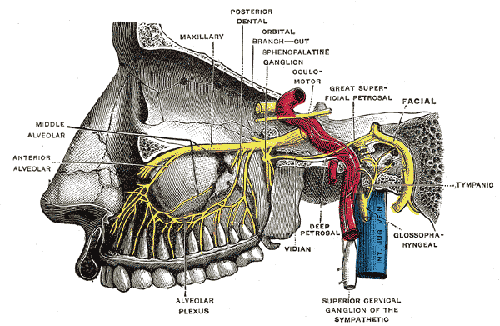Sphenopalatine Ganglion StimulationWhat is Sphenopalatine Ganglion Stimulation? The sphenopalatine ganglion (SPG) is a nerve bundle behind the bony structure of the nose that has been long recognized to be associated with pain pathways of certain headache disorders, such as cluster headache. Why Has Neurostimulation Been Pursued to Target the SPG? The SPG ganglion is an important neural relay station for facial sensation. For that reason, SPG neurostimulation was pursued as a form of therapy to control headaches and facial pains. Ensuing clinical trials indicated that applying electrical stimulation to this nerve bundle via a small neurostimulator, implanted through the back of the mouth, under the cheek of the upper jaw, can moderate nerve activity that occurs in some facial pain conditions, like chronic headaches, which are a major public health problem. (1) SPG stimulation is potentially less economically burdensome than drug treatments that are less effective than neurostimulation in relieving chronic neuropathic pain (2). SPG stimulation has been an available therapy for episodic and cluster headache in Europe since 2012. (2) Recent SPG Neurostimulation Research In Europe, a multicenter clinical trial from 2010 – 2013, the Pathway CH-1 study, showed an overall reduction in disability from cluster headache in participants who used a handheld controller to activate an implanted SPG neurostimulator at the start of a headache attack. Of the 32 participants, 68% had a reduction in pain during the attack of at least 50%, had at least 50% fewer attacks, or both. (2) Results of a subsequent U.S. clinical trial, Pathway CH-2, were reported in December 2019. (3)
The SPG is connected to a complex neural pathway involved in headache that is associated with the occipital nerves along the neck and scalp via a structure called the cervicofacial ramus. Several nerves form the SPG. They branch off from the main facial nerve, the trigeminal ganglion, which is responsible for pain and other sensations of facial structures, including the internal surface of the nose. (Image: Wikimedia)
1. Schoenen J, Jensen RH, Lantéri-Minet M, et al. Stimulation of the sphenopalatine ganglion (SPG) for cluster headache treatment. Pathway CH-1: A randomized, sham-controlled study. Cephalalgia. 2013;33(10):816-830. 2. Pietzsch JB, Garner A, Gaul C, May A. Cost-effectiveness of stimulation of the sphenopalatine ganglion (SPG) for the treatment of chronic cluster headache: a model-based analysis based on the Pathway CH-1 study. The Journal of Headache and Pain. 2015;16:48. doi:10.1186/s10194-015-0530-8. doi:10.1177/0333102412473667. 3. Goadsby PJ, Sahai-Srivastava S, Kezirian EJ, Calhoun AH, Matthews DC, McAllister PJ, Costantino PD, Friedman DI, Zuniga JR, Mechtler LL, Popat SR, Rezai AR, Dodick DW. Safety and efficacy of sphenopalatine ganglion stimulation for chronic cluster headache: a double-blind, randomised controlled trial. Lancet Neurol. 2019 Dec;18(12):1081-1090. doi: 10.1016/S1474-4422(19)30322-9. PubMed PMID: 31701891.
|
| Last Updated on Sunday, November 21, 2021 08:12 PM |

